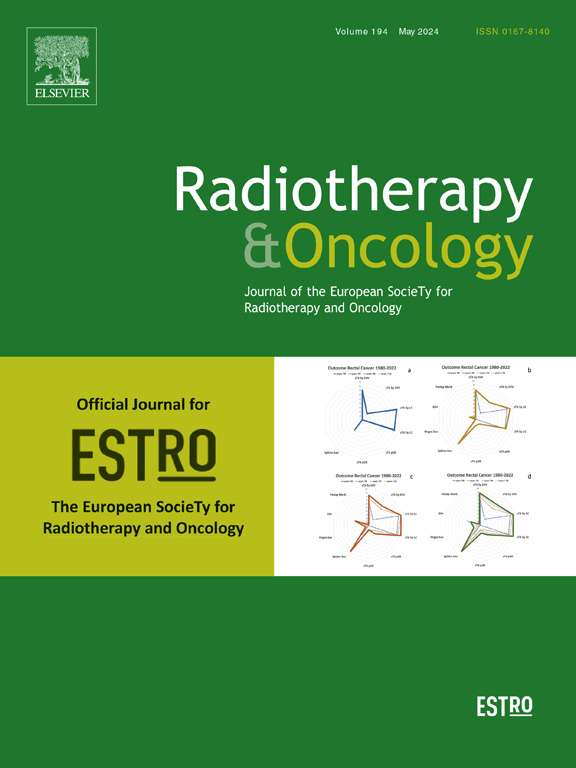深度学习校正锥束计算机断层扫描的每日质子剂量重新计算
IF 4.9
1区 医学
Q1 ONCOLOGY
引用次数: 0
摘要
背景和目的锥形束CT (CBCT)生成的合成CT (sCT)必须保持稳定的性能,并允许在所有治疗阶段进行准确的剂量计算,以有效地支持适应性质子治疗。本研究评估了用于前列腺癌患者在整个治疗过程中生成sCT的3D深度学习(DL)网络。材料与方法采用25/6前列腺癌患者的患者数据对DL网络进行训练/测试。试验集中的患者有计划CT, 39张CBCT图像,至少一次用于重新计划的重复CT (reCT)。将生成的sCT图像与扇形束计划和reCT图像进行比较,包括:1)膀胱、前列腺和股骨头球形感兴趣区域(roi)内CT数的准确性和稳定性;2)通过单点计划计算质子范围的准确性;3)整个治疗过程中靶覆盖的剂量趋势(1例患者)。结果sCT图像显示出与CT相当的图像质量,同时保留了CBCT的解剖结构。sCT和CT图像上的平均CT数是相当的,例如,对于前列腺ROI, sCT的范围从29 HU到59 HU, CT的范围从36 HU到50 HU。最大中位质子距离差为1.9 mm。质子剂量计算显示高剂量靶极好的靶覆盖率(V95%≥99.6%)。结论DL网络可有效生成高质量的sCT图像,其CT数量、质子范围和剂量特征与扇束CT相当。它对患者内部变异的稳健性使其成为适应性质子治疗的可行工具。本文章由计算机程序翻译,如有差异,请以英文原文为准。
Daily proton dose re-calculation on deep-learning corrected cone-beam computed tomography scans
Background and purpose
Synthetic CT (sCT) generation from cone-beam CT (CBCT) must maintain stable performance and allow for accurate dose calculation across all treatment fractions to effectively support adaptive proton therapy. This study evaluated a 3D deep-learning (DL) network for sCT generation for prostate cancer patients over the full treatment course.
Material and methods
Patient data from 25/6 prostate cancer patients were used to train/test the DL network. Patients in the test set had a planning CT, 39 CBCT images, and at least one repeat CT (reCT) used for replanning. The generated sCT images were compared to fan-beam planning and reCT images in terms of i) CT number accuracy and stability within spherical regions-of-interest (ROIs) in the bladder, prostate, and femoral heads, ii) proton range calculation accuracy through single-spot plans, and iii) dose trends in target coverage over the treatment course (one patient).
Results
The sCT images demonstrated image quality comparable to CT, while preserving the CBCT anatomy. The mean CT numbers on the sCT and CT images were comparable, e.g. for the prostate ROI they ranged from 29 HU to 59 HU for sCT, and from 36 HU to 50 HU for CT. The largest median proton range difference was 1.9 mm. Proton dose calculations showed excellent target coverage (V95%≥99.6%) for the high-dose target.
Conclusion
The DL network effectively generated high-quality sCT images with CT numbers, proton range, and dose characteristics comparable to fan-beam CT. Its robustness against intra-patient variations makes it a feasible tool for adaptive proton therapy.
求助全文
通过发布文献求助,成功后即可免费获取论文全文。
去求助
来源期刊

Radiotherapy and Oncology
医学-核医学
CiteScore
10.30
自引率
10.50%
发文量
2445
审稿时长
45 days
期刊介绍:
Radiotherapy and Oncology publishes papers describing original research as well as review articles. It covers areas of interest relating to radiation oncology. This includes: clinical radiotherapy, combined modality treatment, translational studies, epidemiological outcomes, imaging, dosimetry, and radiation therapy planning, experimental work in radiobiology, chemobiology, hyperthermia and tumour biology, as well as data science in radiation oncology and physics aspects relevant to oncology.Papers on more general aspects of interest to the radiation oncologist including chemotherapy, surgery and immunology are also published.
 求助内容:
求助内容: 应助结果提醒方式:
应助结果提醒方式:


